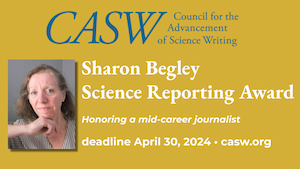By Alexandra Branscombe
For early-career science writers, scoring a byline in a national science magazine can be a daunting prospect. One solution: start small.
“Think Small: How to Write for Local and Non-Science Publications" session, left to right: Rebecca Boyle, Bettina Chang, Christie Ashwanden, and Kristen Schmidt. Photo by Alexandra Branscombe.
Writing for local non-science publications can be an opportunity to write science stories with new angles and build a cache of clips, said panelists during a workshop this weekend at the National Association of Science Writers conference in Columbus, Ohio.
“Your hometown is a breeding ground for national stories,” said Rebecca Boyle, who has written local-turned-national stories that range from beetle kill in the west to goose birth control. Not everything is going to blow up into a national story, but some things can, she said.
In a workshop titled “Think Small: How to Write for Local and Non-Science Publications,” seasoned editors and freelance writers gave conference attendees their tips to successfully pitch and report science stories to non-science publications.
The trick is to pitch a local story with a science angle — and prove why being a science writer is important to telling that story, explained Christie Aschwanden , whose non-science contributions include Runner’s World and Bicycling. “That science angle is your ‘in’ — convince them you are the right person to write this story because you have the science background,” she said.
The best way to do this, the panelists agreed, is make sure a local story is grounded with science and data. This needs to be clear in the pitching process.
“We appreciate when people approach us with a news story that is tied to empirical data to give it a new perspective,” said Bettina Chang, associate editor for the Pacific Standard.
Another editor on the panel, Kristen Schmidt, from Columbus Monthly, said that local and regional publications are a great place to start for early career writers because everyone has access to local stories right outside their front door.
But a local story doesn’t mean an easy pitch: make sure to do the research first. “You all have city and regional [magazines] in your markets that you can call up. But local tone, local voice — that is very important to us,” said Schmidt.
The panelists pulled from their personal experiences in writing and editing local science stories, including beetle kill, medical miracles, novel inventions, and artisanal toast.
“If you frame news in this cloak, or aura, of science, you give this flavor that wouldn’t be pitched by a non-science person,” said Boyle.
Here are some more "do" and "don’t" tips for pitching to local and non-science publications from the workshop panel:
Do:
- Repackage a local science story for a national science publication; it is a good way to stretch your reporting.
- Sell yourself on your scientific expertise.
- Write stories that have a personal connection, it can make the story more powerful.
- Write about current, national themes that play out on the local level.
- Call up local laboratories, research institutions, universities or tech companies; find out what is the latest and exciting new thing in their research.
Don’t:
- Pitch to a magazine you haven’t read. Make sure you understand its tone and style before pitching to an editor.
- Pitch similar stories to competing publications.
- Withhold information from editors: if you are repackaging a story you wrote somewhere else, tell them so in your first pitch.
- Write a short pitch for a long-form story. Use your pitch to justify the length you want to write.
.png)

